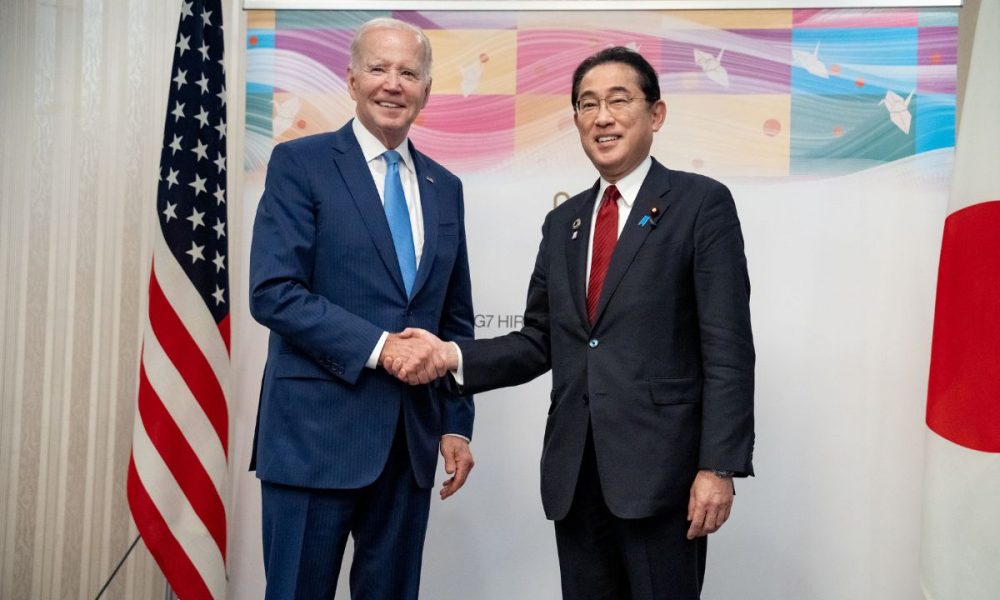Asia
Plan to integrate Japan into US defence industrial base

US President Joe Biden and Japanese Prime Minister Fumio Kishida are expected to agree to strengthen defence industry cooperation at their summit here on 10 April, a US government source told Nikkei Asia.
The cooperation will not be limited to the repair of US Navy ships at private Japanese shipyards, but will also include the joint development and production of ammunition, aircraft and ships.
The leaders are preparing to establish a coordinating body to discuss how to make this vision a reality.
‘Japan is an untapped resource’
The official said the US sees great potential to “integrate” Japan into America’s defence industrial base.
The Japanese embassy in Washington declined to comment for this story.
“We see Japan as an underutilised resource,” the official said, adding that the goal is to take advantage of allies’ manufacturing capabilities, starting with Japan, which hosts the largest overseas contingent of US forces.
Noting that Japan’s manufacturing to GDP ratio is twice that of the US, the official said: “Japan has a very impressive industrial base, but its weight on the defence side is low.
Japanese shipyards can service US ships
The use of Japan’s defence industrial base will begin with ship repair. At the summit, Biden and Kishida are expected to formalise the process of maintenance, repair and overhaul of US Navy warships in private Japanese shipyards.
The US Navy has already tested ship repairs at Mitsubishi Heavy Industries’ Yokohama Shipyard and Machinery Plant, including the USS Milius missile-guided destroyer in 2019 and the USNS Big Horn replenishment ship this year. The Yokohama shipyard, located in Kanagawa Prefecture near Tokyo, is close to the Navy’s Yokosuka base and is likely to serve as the flag carrier for the collaboration.
Other Japanese shipyards already working for the Maritime Self-Defence Force, such as Mitsubishi Heavy shipyards in Nagasaki and Tamano and Japan Marine United shipyard in Kure, are also being considered.
Repairs will initially be limited to two dozen ships based in Japan. This is because US law generally prohibits US-based Navy ships from undergoing maintenance, repair or overhaul at an overseas shipyard.
The US official told Nikkei Asia that a congressional resolution may eventually be needed to expand operations to allow Japanese shipyards to service US-based ships. This would help alleviate maintenance bottlenecks at American shipyards and allow ships to return to service more quickly.
Japanese shipyards could play a role in potential conflict with China over Taiwan
American analysts say that in a possible future conflict between the US and China in the Taiwan Strait, it will be crucial for the US Navy to be able to carry out quick repairs in Japan so that ships can return to the fight rather than spending weeks travelling back to the US.
Meanwhile, the joint production of assets is likely to start with ammunition. The US, which has to supply ammunition to both Ukraine and Israel, is facing a severe shortage of ammunition. Joint production of ammunition with the Japanese defence industry is expected to help replenish stocks for the Indo-Pacific region.
‘It is important to keep co-produced ammunition in Japan’
Jeffrey Hornung, senior political scientist for Japan at the RAND Corp.’s National Security Research Division, said it was important to be able to produce ammunition and keep it in Japan.
“It would be a huge advantage for the United States to have the stockpiles, materials and parts in Japan so that if a conflict breaks out, we don’t have to move it all over here,” Hornung said.
Hornung said it was very important to frame the cooperation in a way that both sides would see it as a win-win: “It has to be explained to the American side that it’s not about losing jobs, it’s not about losing contracts, it’s about reducing logistics and our allies will fill the gap.
For the Japanese side, meanwhile, he said that increased business should encourage Japanese defence companies to invest in capacity. Although Japan has announced that it will increase its defence spending over the next five years, raising it from 1% to 2% of gross domestic product, this has not translated into major investment.